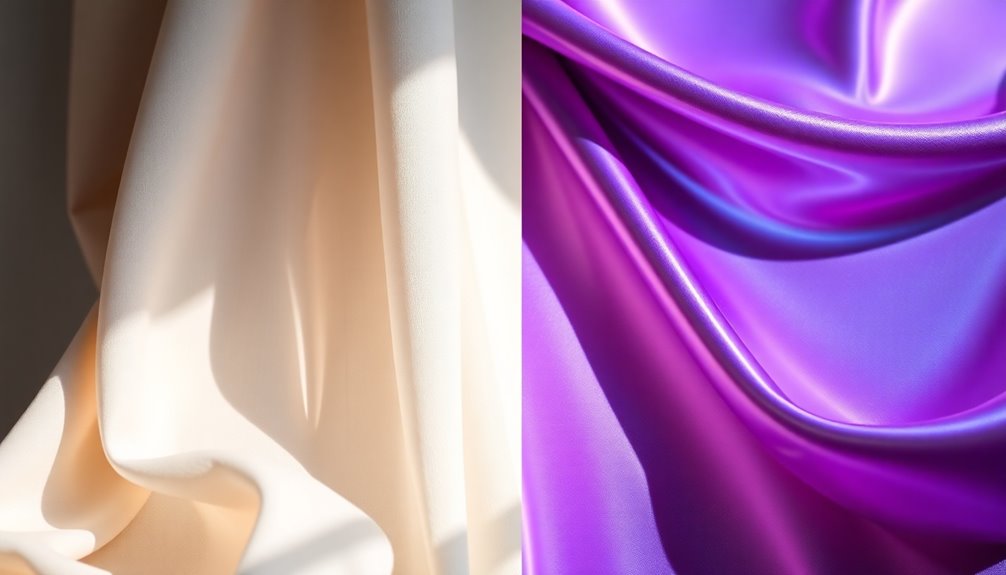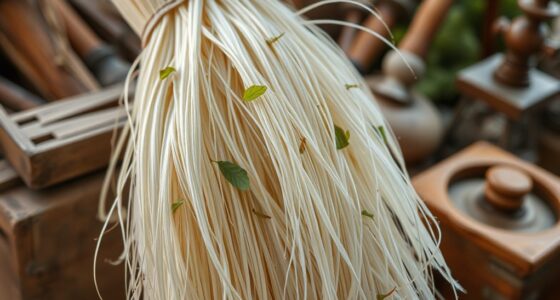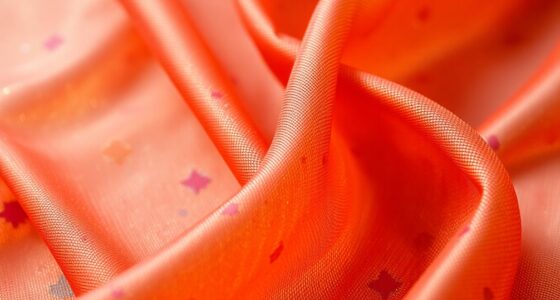When comparing cotton material to Supima cotton, you'll find Supima is superior. It's made from extra-long staple fibers, making it twice as strong and softer than regular cotton. Supima also offers better breathability and color retention. While conventional cotton often relies on excessive water and pesticides, Supima follows sustainable practices. Although it comes at a higher price, the long-lasting quality and comfort make it a worthwhile investment. Discover more about its unique advantages next!
Key Takeaways
- Supima cotton features extra-long staple fibers, making it stronger and softer than regular cotton.
- It offers superior breathability and moisture absorption, enhancing comfort for sensitive skin.
- Supima cotton's durability reduces waste and promotes sustainable consumption compared to conventional cotton.
- The vibrant color retention of Supima cotton outperforms standard cotton, ensuring long-lasting aesthetics.
- Although more expensive, Supima cotton's premium quality and hand-picking methods justify the higher cost.
Understanding Cotton Material

Cotton material, renowned for its versatility and comfort, is a natural fiber that offers a unique blend of properties. Its chemical composition is primarily cellulose, making up 91% of the fiber, with a moisture content of 7.85%. The fibers are fairly uniform in width, ranging from 12 to 20 micrometers, and can vary in length from 1 to 6 centimeters. Cotton boasts high breathability and excellent moisture absorption, making it comfortable against your skin. Interestingly, India is the largest producer of cotton globally, which contributes to its availability and popularity. Its durability is notable, as it resists acids, alkalis, and organic solvents, although prolonged sunlight can weaken the fibers. You'll appreciate how easy it's to clean and how natural it feels, enhancing your everyday wear and experience.
The Unique Qualities of Supima Cotton
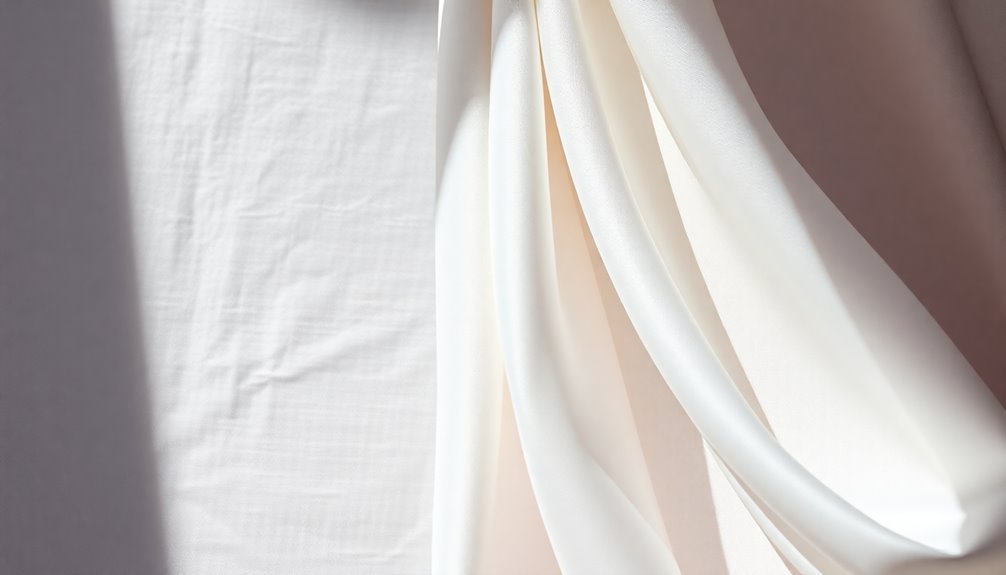
Supima cotton stands out in the world of textiles due to its exceptional qualities and superior craftsmanship. Grown primarily in California, this premium variety features extra-long staple fibers that are about 35% longer than regular cotton. Because of this, it's not only twice as strong but also incredibly soft, making it a luxurious alternative to silk. You'll appreciate its breathability, perfect for warm climates, and its resistance to pilling, which keeps your items looking new longer. Additionally, its unique long fibers contribute to its extraordinary comfort and durability, making it an ideal choice for those seeking high-quality fabrics. Supima cotton also boasts excellent color retention, ensuring vibrant hues in your clothing and linens. Although it represents less than 1% of all cotton grown globally, its quality and durability make it a worthwhile investment for luxury bedding, high-end clothing, and plush towels.
Environmental Impact of Cotton vs. Supima Cotton

While the textile industry grapples with environmental challenges, choosing between conventional cotton and Supima cotton can greatly impact sustainability.
Conventional cotton often requires excessive water and relies heavily on harmful pesticides, which can degrade soil and water quality. In contrast, Supima cotton is cultivated in the U.S. using water-saving techniques and reduced chemical use, making it a more eco-friendly option. Furthermore, Pima cotton's long fibres contribute to its overall durability, ensuring that Supima cotton garments last longer, decreasing waste and the need for frequent replacements. This longevity supports sustainable consumption, while organic cotton, though chemical-free, may not offer the same durability.
Cost Comparison: Cotton Material vs. Supima Cotton
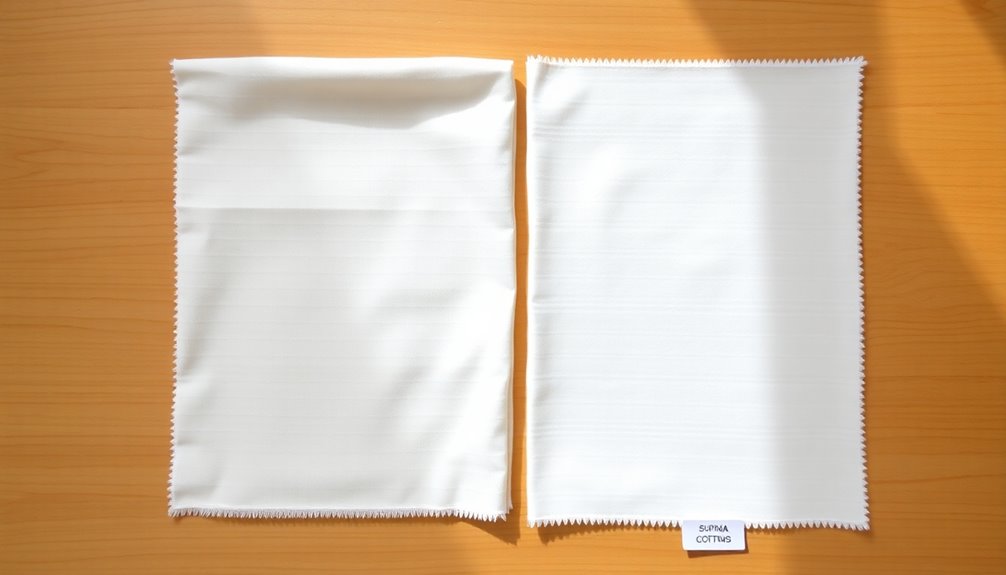
When comparing the costs of cotton materials, it's clear that Supima cotton typically comes with a higher price tag.
You'll find that Supima cotton fabric can range from $15 to $30 per yard, while luxury bedding sets can cost between $100 and $300. This premium pricing stems from its superior quality, hand-picking methods, and regulated production processes. Supima cotton is often twice as expensive as regular cotton due to its limited availability, making up only 1% of global cotton production. The demand for durable, comfortable, and sustainable products further drives up its cost. Additionally, the cultivation of Supima cotton involves advanced irrigation systems that enhance water efficiency, contributing to its premium status.
While it's an investment, many consumers appreciate the long-term value Supima cotton offers, justifying the higher price for its quality and comfort.
Health Benefits: Cotton Material and Supima Cotton
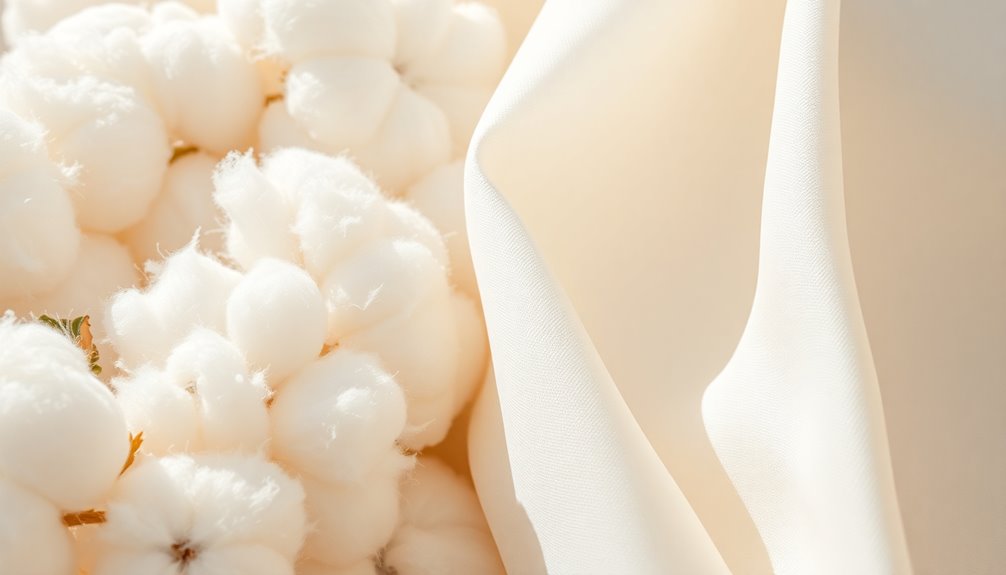
Choosing the right fabric goes beyond just cost; it also involves considering the health benefits each material offers.
Cotton fibers are hypoallergenic, making them ideal for sensitive skin. They're breathable, allowing air circulation to prevent moisture buildup and bacterial growth. Plus, cotton absorbs moisture, keeping you comfortable and reducing skin issues like rashes.
Supima cotton enhances these benefits with its luxurious feel and extra softness. It's up to 50% stronger than regular cotton, ensuring durability and better moisture management. This exceptional strength results from its extra-long staple fibers, which contribute to its durability.
Both materials are hypoallergenic, but Supima's superior quality may reduce irritation further. Additionally, Supima's eco-friendly cultivation practices boost its sustainability profile, making it a healthy choice for you and the environment.
Frequently Asked Questions
Can Supima Cotton Be Used for All Types of Clothing?
Yes, you can definitely use Supima cotton for all types of clothing.
Its versatility allows it to be crafted into various fabrics, like jersey, sateen, and twill, making it suitable for everything from T-shirts to dress shirts and nightgowns.
With its softness, breathability, and moisture-wicking properties, it's perfect for activewear too.
Plus, it's commonly used in home textiles like bedding and towels, providing a luxurious touch throughout your wardrobe and home.
How Does Cotton Production Affect Local Economies?
When you consider the gentle influence of cotton production, it's clear it plays a pivotal role in local economies.
By generating jobs and revenue, it nurtures communities, offering employment opportunities for both skilled and unskilled workers.
You'll find that local businesses thrive through increased spending on inputs like seeds and fertilizers.
This economic activity creates a ripple effect, enhancing overall prosperity and stability in rural areas, making cotton a cornerstone of local livelihoods.
Is Supima Cotton Available in Organic Form?
Yes, Supima cotton is available in organic form.
You'll find Organic Supima cotton combines the luxurious qualities of Supima with eco-friendly farming practices. It's grown without toxic pesticides or fertilizers, which enhances soil health and reduces environmental impact.
When you choose Organic Supima, you're not only enjoying its premium softness and strength, but you're also supporting sustainable agriculture and better conditions for farmers.
Look for GOTS certification to guarantee its quality and sustainability.
What Certifications Should I Look for in Supima Cotton Products?
Choosing Supima cotton is like selecting fine wine; you want the best quality possible.
When you're looking for Supima cotton products, check for certification from the American Supima Association (ASA). This guarantees you're getting 100% U.S.-grown Pima cotton, meeting strict quality standards.
Look for the Supima trademark, as it ensures the product's authenticity, durability, and luxury feel. This certification builds your confidence in the product's quality and origin, enhancing your overall experience.
How Can I Identify Authentic Supima Cotton?
To identify authentic Supima cotton, look for the Supima label on the product, which assures quality and traceability.
You can also check for certifications that indicate it's been grown in the U.S. and meets specific standards.
Additionally, feel the fabric; Supima cotton has a softer, more luxurious texture compared to regular cotton.
Finally, brands that use blockchain technology for traceability can provide you with verified authenticity throughout their supply chain.
Conclusion
In the battle of cotton material versus Supima, think of it as choosing between a cozy, familiar blanket and a luxurious, silky robe. While both have their merits, Supima's superior softness and durability shine like a star on a clear night. The environmental and health benefits sway the scales further, making it a worthy investment. So, whether you wrap yourself in cotton's comfort or indulge in Supima's elegance, you're in for a treat that embraces you like a warm hug.
